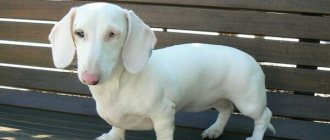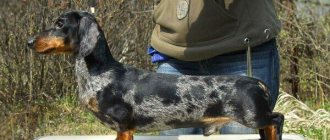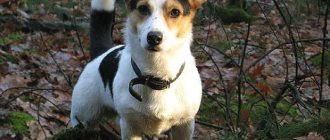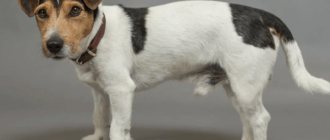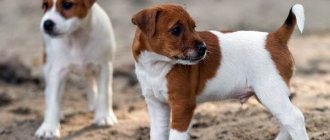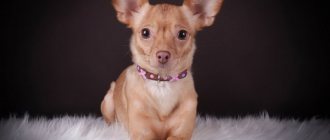Black coloring is rare in Jack Russell Terriers.
But such dogs look impressive and elegant.
People who decide to buy a pet of this particular color should be aware that they may have to spend more than one month searching for such an unusual dog.
Why are black Jack Russells so rare?
And why is this color not even mentioned in the breed standard?
Let's try to figure this out.
Origin story
The first breeder of this breed, the English priest John Russell, lived in the second half of the 19th century and, like many of his compatriots, was fond of hunting and breeding hunting dogs similar to the old-type fox terriers.
Due to the fact that Russell was not interested in the exterior characteristics of his dogs and because he was aimed at breeding the ideal hunting terrier, in order to improve the quality of the stock, he often crossed his dogs with representatives of other breeds, including black individuals.
Thus, the first black Jack Russells appeared during the lifetime of the first breeder of the breed.
In the 20th century, in order to improve the fighting qualities of dogs, breeders infused them with the blood of bulldogs and crossbreeds of bulldogs and terriers, thanks to which the black color became even more entrenched at the genetic level.
Currently, black Jack Russell Terriers are still being born infrequently, but such puppies can appear in ordinary white-black or tricolor dogs.
Tricolor
Dogs with a tricolor are born black and white. The reddish or brownish markings are fully formed when the dog is one year old. Sometimes puppies are born with three shades at once. Young animals may have white hairs in the black zone, but this feature is temporary.
Black-red-white. The most common color variant of the Beagle, which is why it is called “classic” or “traditional”. The most common color is anthracite-fiery white. The colors are evenly distributed throughout the body, the boundaries of each shade are blurred. In contrast to the “classics” there is a weakened (blurred) tricolor. There are quite a lot of variations of weakened shades.
Blue tricolor
The blue tricolor is due to genetic characteristics. The gene “lightens” the dog’s colors, turning black into gray and brown (red) into cream. When the color is blue, the iris of the eyes also changes. It becomes lighter - closer to yellow. The nose also acquires a lighter pigment (gray or slate). Often, it is the shade of the nose that can determine the blue color of a Beagle puppy. The color is otherwise called smoky, gray or silver.
A genetic mutation can lighten the black gene to light gray shades. The silver color is called lilac tricolor (“khaki” or “mocha”). Sometimes puppies are born traditionally tri-colored, but later the white coat becomes covered with small spots. This feature is called blue-freckled color.
Chocolate
Chocolate (liver) tricolor also belongs to the weakened type. In this case, the black gene takes on a brown tint, completely replacing all dark tones. The chocolate version is characterized by the fact that it goes in combination with the light green eyes and brown nose of the Beagle. The black color is lightened to varying degrees: from dark liver to almost creamy shades.
A variation of the chocolate tricolor is the lilac color. “Purple Chocolate” is unique in that the brown tint goes together with blue. This combination forms a whole shimmer of colors, which is called “isabella”. The chocolate (liver) color is not recognized by the FCI and therefore not in the UK. All puppies of this color are completely discarded and are not allowed for further breeding. The situation is the opposite in the USA and Canada - the color is officially registered, and “liver” Beagles often receive high marks from experts.
The chocolate tricolor is considered a disqualifying fault for two reasons: it may indicate that the dog is not purebred, or that the individual has poor vitality. The accumulation of recessive genes can lead to subsequent genetic abnormalities in other generations.
Spotted
The spotted color belongs to the tricolor group. In other words, it is called torn or open. The dominant color is white, which divides the “traditional” version of the tricolor, turning it into spots. Sometimes white covers almost 80% of the dog's body, leaving a few small black or tan colored markings on the Beagle.
Marriage or breed?
The following colors are allowed by the standard:
- White and red.
- White black.
- Tricolor (white-red-black).
- Pure white if the dog's nose, eyelids and lips are completely pigmented black.
In this case, white color should predominate in the color: it should be no less than 51%.
The black color is not mentioned in the standard, and therefore this color is a defect in the breed.
Expert opinion
Kozhevin Semyon Kirillovich
Expert dog handler.
“The black Jack Russell terrier looks very elegant. Due to its non-standard color, such a dog involuntarily attracts the glances of passers-by who are accustomed to seeing white-red, white-black or tri-colored representatives of this breed in movies and advertising. The black dog is no different from other Jack Russells: he is the same brave and tireless lover of running and playing, and at the same time devotedly loves his owners. Black Jack Russells do not require complex care and are unpretentious in terms of feeding. They will be able to take root perfectly both in a private house and in a small city apartment.”
Two-color
Bicolor is the color of a Beagle, consisting of two colors - white (closer to cream) and a shade of red. The pigment responsible for redness manifests itself in different intensities:
- red;
- ginger;
- citric.
The division of tones is conditional; there are transitional variations between them. The standard allows all shades from red to light lemon. It is bicolor that is most popular in the UK.
Red is considered the rarest. Its saturation is often compared to brick, but the color is called “mahogany” in another way. The remaining shades between red and lemon are variations of the red tone. Very often the light red color is mistaken for the lemon Beagle color.
Bicolor puppies are most often born completely white and darken closer to the age of one year. However, there is still a way to determine the exact color color: the darker the nose, the lighter the coat. The lemon white Beagle has nose pigment closer to black. Red and white dogs have a more light brown nose.
Sometimes the color of the nose can also change color (from light to dark). This can happen in bitches, in whom the phenomenon depends on the hormonal cycle.
White - red
It is the white and red one that is most often found among bicolor Beagles. It exists in a wide variety of variations: from dark, rich tones to almost pale cream shades.
Interpretations of the red bicolor are very often subject to doubt and controversy. It is easy to confuse it with the unique lemon color or classify the bright shade as a rare red and white. Only experienced beagle breeders are able to independently determine the color of a dog.
It is incorrect to consider the dominant color of the Beagle to be pure white. It is slightly darker than snow white and closer to a light cream or creamy shade. The combination of light cream color and white is called lemon.
Citric
Lemon color is considered the unique color of the breed. It is very difficult to identify, especially for a novice breeder. Lemon color is achieved by maximizing the lightening of the gene responsible for dark colors. Puppies with this color have a dark (almost black) nose from birth.
Lemon shade is a pale cream color that is only slightly darker than base white. A more saturated tone already belongs to red-and-white, although many mistakenly classify it as “lemon”. The principle of determination is simple - the lighter the red pigment, the closer it is to lemon.
Speckled or speckled
Specks are one of the options for displaying tricolor and bicolor. It is characterized by the presence of small black or red spots on the entire body (or in certain areas), as in the photo. The spots can form in large numbers (dense) or at a great distance from each other (sparse). Speckled is not a spotted variety and has nothing in common with the blue merle (merle) color.
Discoloration is genetically determined. You can recognize it in newborn puppies: their paw pads are never pink. The real mark appears already by 4-5 days from birth. Sometimes puppies acquire it at 6-8 weeks.
Motley
The variegated color occupies an ambiguous position. Essentially, it is a combination of two colors, but in different shades. Officially, variegated varieties are recognized only in the UK and the FCI. In total, they identified 3 varieties:
- badger motley (the rarest and most intense, black color predominates);
- hare motley (dominance of red color);
- lemon variegated (lightest).
Most pieds are recorded in the UK, but this does not mean that they are only found in one country. This variety is not rare and sometimes you need to look closely to see the variegated color in the muted tricolor.
Beagle breeders have never come to a consensus on which color combination to accept as a variegated color. Some argue that the presence of “agouti” is sufficient (zonal coloring - the tip of the hair is black, the rest is brown). Others believe that it is necessary to “mix” the brown and black hairs on the Beagle’s body.
With a variegated color, there is no pure snow-white color. It is more reminiscent of creamy or creamy (as is the case with standard bicolor). The color smoothly flows into another shade, which is similar to the usual classic tricolor.
Advantages and disadvantages
Advantages:
- Black Jack Russells are small and, due to their compact size, these dogs can live both in a country house and in an apartment.
- They will never refuse to run and play.
- Black Jack Russells are good with children.
- Extraordinarily loyal dogs: they try to accompany their owner everywhere.
- Known for their intelligence and intelligence.
- Caring for this dog is not difficult.
- If the pet is wire-haired or has a transitional coat, then it does not shed.
- The black Jack Russell's coat cleans itself.
Flaws:
- The hyperactivity of such a dog may not please all people.
- Left alone, he gets bored and because of this he may start chewing furniture or peeling off the wallpaper in the room.
- He digs up the soil in the flower beds, and at home he turns over flower pots and tries to make holes in the floor.
- The Black Jack Russell needs proper education and early socialization, without which it can grow up willful, disobedient and aggressive.
- Due to its natural hunting instinct, it can be hostile towards other animals.
- He knows how to cunning and manipulate his owners.
- If your pet is wire-haired or has a transitional coat type, it needs trimming.
Black Jack Russells are strong and resilient: they can do sports such as agility..
Rules of care
Even when you are thinking about buying a Labrador puppy, you should take care of the place where your new pet will live. You should also be prepared for the fact that a brown Labrador will need to not only be combed, but also bathed.
Hygiene procedures directly affect the health of the dog.
It’s not limited to caring for the animal’s fur. You also need to take care of the ears, mouth (teeth) and claws of your brown Labrador.
The dog's ears should be clean and not spread an unpleasant odor around. They can be treated once a week with a cloth dampened with warm water or a special solution that can be purchased at pet stores.
The rag must first be wrung out well so that the liquid does not flow into the dog’s ear. For your animal's teeth, you can purchase a special brush and toothpaste, or you can contact a veterinarian.
Brown Labradors that walk a lot usually do not need to have their nails trimmed, but if your dog does need a “manicure”, then you need to trim the nails in a way that does not harm the dog - with a special nail clipper.
You should carefully monitor the condition of your eyes and nose.
You need to find a middle ground in the frequency of bathing - it is not recommended to bathe your dog often. Even specialized washing products can lead to skin irritation and dry epithelium.
You should bathe your pet in warm water using dog shampoo. Experts advise bathing your Labrador once a week.
As for walks, the Labrador needs to be accustomed to them from childhood. For a puppy, going outside should be kept short - the dog should not become hypothermic. Over time, the duration of the walk increases.
IMPORTANT!
You need to allocate at least two hours a day for walking; for training, you need to walk the dog for 3-4 hours once a week.
Experts advise feeding your Labrador without mixing natural food and industrial feed. A breeder or veterinarian will help you choose a diet specifically for your puppy.
If you choose natural food, it should be fresh and balanced. It is dangerous for your pet’s health to feed your Labrador with salty, sour, fatty, spicy or sweet foods.
If you feed your dog commercial food, it must be of high quality.
Dimensions, weight and other distinctive features
Like other varieties of this breed, Black Jack Russells come in two types.:
- Short-legged (height from 25 to 30 cm, weight 5-6 kg).
- Long-legged (male height - from 34 to 38 cm, female height - from 31 to 35 cm, weight - approximately from 6.5 to 7.5 kg).
Their body format is stretched or rectangular, their physique is strong and proportional:
- The head is in the form of a blunt wedge, the skull is wider and longer than the muzzle. The stop is quite well defined, but not sharp.
- Ears can be one of two types: raised (“button”, as they are also called) and drooping.
- The eyes are small, brown, and in no way protruding.
- The edges of the eyelids, nose and lips are black.
- The neck is moderately elongated, not thin, but not too powerful.
- The withers are well defined, the back is level, the loin is not long. The chest is oval in shape, reaching the line of the elbows.
- Limbs are strong and muscular. The paws are round in shape, the toes are arched.
- The tail can be docked or left long.
One of three main types of wool:
- Smooth, lying close to the body, with a well-defined undercoat, which, however, should not be fluffy or too thick.
- The coat is longer and coarser than that of smooth-coated dogs, with one or more kinks.
- The coat is coarse, but finer and softer than, for example, the wiry coat of the Wire Fox Terrier.
Color: black or black with small white spots: for example, a barely noticeable blaze on the muzzle.
If the dog's tail is docked, then its tip should be at ear level.
What determines coat color?
In mammals, black and yellow pigments are produced, which are contained in granules of hair hairs. They determine the color of the animal’s coat.
Black Pekingese - the color is dominant. But, when crossing black Pekingese with any other colors, it is not a fact that the puppies will be the same black. Black dogs carry genes that cause the development of different colors. A litter may produce puppies that are completely different in color.
The Pekingese has a black and white coat - the color depends on the distribution of coloring pigments in the hairs of the coat. The location of the pigment can be ring-shaped. In this case, the hairs are colored unevenly.
The black color often allows white markings on the paws, forehead and chest. The color has different shades. The hair is characterized by a red color with dark tips of varying lengths.
With a short dark tip, the red color will predominate. If the dark pigment at the end of the hair is longer, the red color will appear darkly rippled, almost black or gray.
The repetition of such rings, i.e., the alternation of yellow and black pigment, forms a zonal coloration. If the black pigment is located at the tip of the hair, and yellow at the base, then the coat will be sable, deer or red with blackening, according to the terminology of French dog handlers.
The ring arrangement of pigments can be of different widths. If distributed evenly, the color will be zoned gray. If the yellow stripes in the ring are wider, then it is reddish-gray.
It is quite difficult to separate colors in puppyhood; the color is defined as gray-fawn or fawn. More often this color is found in combination with a black mask.
The pigment pheomelanin comes in a variety of shades - from yellow to red. The presence of pheomelanin color determines the intensity of the red color common among Pekingese - from light fawn to red-red.
Sable puppies change coat color as they age. If at birth they are dark gray or black, then with age the undercoat becomes lighter, and the growing outer coat turns red.
When babies are immediately born red, only the color intensity changes with age. Red Pekingese can be of any color. When mating with the same red dogs, you can get a wide variety of colors in the litter.
The gray color of the Pekingese varies from light to dark brown, almost black.
Such a variety of shades is found in the guard hair and in the undercoat. This color is also called zone gray among Pekingese.
Dog handlers in Great Britain and the American Kennel Club call this coloring Wild sable, Wolf sable (wild sable or wolf).
White Pekingese are, in fact, very bleached red individuals. The combination of some genes leads to a strong lightening of the red color, even white. This genetic factor is also responsible for the cream color of the Pekingese. The bleached undercoat enhances the impression of white.
The black and tan color is characterized by a constant arrangement of tan marks in strict places: above the eyes, on the cheeks, chest, around the anus, on the inner thighs, on the paws. It is difficult to see the clear outline of the tan contour of the Pekingese due to the long hair and shortened muzzle.
The color of tan marks depends on pheomelanin and ranges from light yellow to dark red.
White spotting can appear in the form of individual white spots. Or it is the main white color of the Pekingese, on which there are spots of a different color. This is caused by depigmentation genes or a break in pigment on the dog’s body. Usually the spots do not merge with each other.
Life expectancy and health
Black Jack Russells are characterized by good health.
Their average lifespan is between 13 and 16 years, but Jack Russells have been known to live for 20 years or even longer .
NOTE!
Despite the fact that representatives of this breed have a hereditary predisposition to certain hereditary diseases, they rarely suffer from them.
However, you need to keep in mind that these dogs can develop genetic diseases of the eyes and musculoskeletal system.
Genetics of colors
Despite a certain distinctive appearance, Jack Russell Terriers are quite distinct from each other within their group. Animal genetics plays a big role here. According to the type of structure, their coat can be:
- long and coarse, it is also called the long-haired and wire-haired variety;
- short and smooth, called short-haired and smooth-haired;
- Brocken - a specific type of coat between the wire-haired and smooth-haired types.
Regardless of the type of coat, all dogs of this species still belong to the same hunting breed of Russell Terriers, but they have different genetics of coat structure and color.
Note! All varieties of wool are quite dense in texture, which is due to genetics. To hunt and move quickly, you need reliable protection.
If we talk about the genetics of colors, then among the representatives of the breed it is almost impossible to find animals with multi-colored fur. This type of pet is not intended for beauty, but still in the modern world many acquire them for presentation at exhibitions. Therefore, there is a practice of breeding Jack Russells of tricolor colors.
The most dominant coat color is white. Genetics also plays here, because during hunting it is very important that owners do not shoot their pets instead of animals. The creator of these animals himself feared this, so the breed was bred on the basis of the white terrier. The remaining tones present on the dog's coat should not predominate. But these spots make the coloring more noticeable and characteristic. This may be why the red and white coat of the Jack Russell Terrier is the most recognizable of all other breeds.
How to choose?
Due to the fact that this color is rare, there is a high probability that a mixed breed or mongrel will be sold under the guise of a Jack Russell.
to buy a black Jack Russell puppy with documents - from a nursery or from a good breeder who is not trying to pass off a faulty breed as exclusive .
When choosing a puppy, you need to pay attention to its health and behavior.
CAREFULLY!
You should not buy a baby with signs of illness, thin or, conversely, overfed, or one whose behavior does not correspond to the breed characteristics: for example, too timid for a terrier or inactive.
But an aggressive or hyperactive puppy is also not the best choice.
A puppy with a good psyche willingly plays with his brothers and sisters, he is moderately active, playful and curious towards people.
Black Jack Russells are not common, as breeders do not specifically breed such dogs.
For this reason, finding such a pet is not so easy. But it’s better to wait until a black puppy appears in a good nursery than to buy something that only vaguely resembles a Jack Russell.
Anyone who buys a real black Jack Russell will receive a wonderful, faithful and devoted friend, who, in addition, also has a unique appearance.
Nutrition
What it will be - natural, industrial or mixed - depends solely on the owner. Lamb and pork are prohibited . Among other products we can recommend:
- Lean meats (beef, turkey, veal and chicken).
- Sea fish without bones.
- Cereals: rice and buckwheat.
- Vegetables (except legumes) with the addition of a teaspoon of sunflower oil.
- Fermented milk products, including kefir and low-fat cottage cheese.
- Quail and chicken eggs (once a week).
Do not indulge your dog with sweets: they can provoke allergies and cause dental and liver diseases.
With a natural menu, add vitamin and mineral supplements to the food that are beneficial for the teeth and dog’s coat.
Strength of genotype
It is noteworthy that the genotype of each color has its own strength and can either dominate or become recessive. The strongest color is black. It suppresses all other colors. In second place is the brindle color, dominant over black and tan and red and white. Red and white suppresses black and tan, but the dog can be its carrier. Black and tan is the weakest color in the Basenji genotype.
It may not manifest itself, but some individuals pass it on to subsequent generations. In order for the offspring to be of this color, the carrier must be mated only with a black and tan individual. It is noted that mating a brindle with a black and tan increases the risk of producing offspring with unregistered colors (most often trindle).
The Basenji's color genetics are unusual, but generally predictable. Each dog passes on from generation to generation 2 genes responsible for the color scheme. From crossing black and tan parents, puppies of the same color will be born, but if one parent is brindle, then brindle or red and white offspring will be born. Each genotype has an individual strength, with black being the most predominant shade. Displays of unrecognized colors are also common.
Locus E (Extension)
The order of dominance is Em > Eg > E > Eh > e. According to the results of genetic studies, five genes are located in the E locus. The most dominant Em gene is the mask color, the eumeline mask on the dog’s face. The next most dominant gene is Eg - the “reverse” mask - a specific lightening on the face, known in two breeds: Afghan and Saluki (domino and grizzly colors). Gene E – normal distribution of eumelanin. The Eh gene is the sable color of English Cocker Spaniels. Gene e – recessive red color.
The DRT breed has only two genes of this locus - Em and E. The presumptive existence of a mask color in the breed, identified by existing external characteristics and the nature of their inheritance, still requires additional genetic examination, since the presence of Au-fawn color often gives characteristic blackening in various breeds on the face, which can often be confused with a mask color. The recessive red color E is not common in the breed, but individual individuals are found and, alas, more and more often...
At first glance, the recessive red ee is similar to the dominant Au-red, and it is not always possible to distinguish these two colors in an adult dog, although unlike the Au-red, the ee-red will never have the slightest admixture of eumelanin (black pigment). But since with Au-red in an adult the human eye cannot always see the individual few granules of black pigment in the coat, almost 100% results are obtained by examining puppies in the first weeks of life. Au-red puppies are always born with an admixture of black/brown hair (as if the puppies were dirty), and ei-red puppies are pure red from birth. Based on this distinctive feature and because the breed never produces red puppies from two tan individuals (At-At), although the result of the birth of tan individuals (At-At) from two Au-red individuals is quite expected, we can conclude that her-red color is fortunately it did not penetrate the breed.
This color is epistatic to all other colors, that is, the combination of its two genes in the genotype always gives a red color, regardless of which genes are located in other color-forming loci.
Recessive red color is found in the following breeds: English Setter, Irish Setter, Irish Terrier, Scottish Setter, Beagle, Dalmatian, Labrador, Golden Retriever, Labrador, Pointer, Poodle, English and American Cocker Spaniels, Russian Spaniel, Chow Chow, Field spaniel, scotch terrier.
But a lot of time has passed since then, and the periodically emerging fashion for rare colors pushed breeders in some countries to make interbreed matings, and now genetic examination finds the gene in breeds where there was no recessive red color at birth. The spread of the e gene across different breeds very clearly demonstrated the level of control of purebred breeding on the part of breeders.
Locus T
Genes T > t. The genes of this locus determine the presence or absence of small pigmented spots on white areas. This phenomenon is called teak spotting or speckling. The dominant gene T is speckled, the recessive gene t is the absence of speckling. The T gene can only appear if the dog has white markings (it is simply not visible on a colored one (which makes detection difficult) and is the result of a secondary wave of pigmentation, since it appears in puppies only 2-3 weeks after birth.
It should also be noted that the T locus is responsible only for the formation of pigment cells, and what pigment these cells will further produce depends on the color-forming loci. For example, on the body of an Au-adult individual, the markings will appear in the form of small spots (red in a bicolor dog), while on the body of a dog with a tan At-At color, the markings will be two-colored, in the tan zone - red, on the rest - black. On the body of a saddle-backed Asa dog there is red on the paws, shoulders, head, neck, and black in the saddle area (back).
Speckling in the DRT breed is not prohibited by the standard, but is considered an undesirable trait, and therefore is not welcome, and certainly not worth breeding when both parents are spotted.
Parson aka long-legged
In the history of the formation of the breed, there was real confusion for a long time. It should be noted right away that there is no division of the Jack Russell Terrier breed into long-legged and short-legged.
So why do Russells have different length legs? The answer to this question lies in the fact that the long-legged terrier is a representative of a different breed called the Parson Russell Terrier.
According to the type of coat, the Parson Terrier can be smooth-haired or wire-haired, it always has a good undercoat. The division of the breed into two varieties, Jack and Parson, occurred in 2001. As a result:
- The Jack Russell Terrier has short legs and a strong build, reaching no more than 30 cm at the withers (FCI standard No. 345). The breed was popularized in Australia.
- The Parson Russell Terrier has tall legs and an elegant build; its height at the withers is no more than 36 cm (FCI standard No. 339). The breed was popularized in Great Britain.
The Parson Russell Terrier is faster at running; at one time it took part in horse hunting. It was this quality that made him a favorite of the kingdom of Great Britain, where from time immemorial horses and hunting were signs of aristocracy.
Funny and short-legged Jacks were not held in high esteem in their historical homeland and were practically driven into a corner as an unnecessary breed.
Whatever the appearance of the Russell Terrier, it owes its origin to the founder of the breed, Russell John, a clergyman and an ardent lover of hunting.
And if so, then all Russells are blood brothers and each of them contains the genes of the very dog from which they descended. It follows that they all have typical breed traits and descriptions:
- Character – lively, charismatic, inquisitive, agile, cheerful, loving. Hunting qualities are pronounced.
- Diseases that are inherited are hip dysplasia, congenital deafness, aseptic necrosis of the femoral head (Legg-Perthes disease) and an eye abnormality called “collie eyes” (improper development of areas of the eyes).
- Any Russell Terrier requires regular training, always with physical activity. Possessing increased jumping ability, this breed can perform intricate tricks and does not mind showing off its abilities in agility.
- Feeding Russells, regardless of coat type and leg length, must be of high quality, balanced and portioned, since they are all prone to obesity.
- Tail docking is not mandatory and does not affect the show career of Russell Terriers. As a rule, docking is carried out in early puppyhood to the length of the “grip handle”.
- In the cold season (at temperatures of -5C and below), Jack Russells and Parsons are dressed in clothes. Short-haired varieties of this breed are especially prone to colds.
- Caring for Russells is standard. Comb the coat and trim it if necessary. Take care of your eyes and ears. Vaccinate and treat for fleas and ticks.
- Puppies of this breed up to 3 months of age have practically no signs of future coat structure - this also applies to Jack Russells and Parsons.
- The price of puppies with documents depends on the pedigree of their parents, as well as their exhibition career. It varies from 30 to 80 thousand rubles. Without a pedigree, puppies are sold for 10-20 thousand rubles. Cheaper offers are either culls or crossbred puppies.
There is no point in making a comparison between the Jack and Parson Russell Terriers. They are similar in their bright temperament and tricolor color; they are distinguished only by the structure of their coat and the height at the withers.
Owners of the Russell Terrier breed are unanimous in their opinion that this dog is not suitable for everyone. She needs an active owner who can cope with the complex and restless nature of the hunting terrier. You can find reviews from those who call this breed too hyperdynamic and even extravagant.

